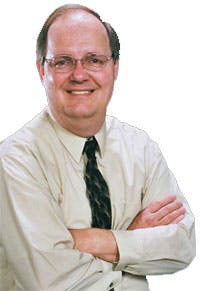Last month we commemorated the 60th anniversary of Hydraulics & Pneumatics magazine. This month, we must bid farewell to a man who had been a part of H&P for all but two of those years: Paul Rolnick. Even after he was promoted to corporate vice president more 40 years ago, and retired nearly 20 years ago, he kept in regular contact with the H&P staff to keep current and offer advice. But Paul was more than a former editor and publisher of H&P. He might have been the most influential person to help shape the U.S. fluid power industry.
The state of today’s fluid power technology is a result of the ideas and actions of hundreds of engineers, designers, inventors, and other innovators. The fluid power industry, on the other hand, consists of the many companies, educational sources, and other organizations that promote the sharing of knowledge and ideas that continue to advance and expand the application of fluid power technology.
Paul, who passed away on March 3, began his career with H&P in 1950 — just two years after its inaugural issue. This was also the time when many of today’s fluid power companies came into existence. There was no National Fluid Power Association or Fluid Power Society in 1950. But he helped change that within only a few years. He helped organize the formation of the NFPA so companies (even competitors) could work together in achieving the mutual goal of advancing the application of fluid power. He also helped organize the Fluid Power Society for individuals to share and expand their knowledge of fluid power.
But I don’t want to imply that Paul was some stuffed-shirt executive. To the contrary, I knew Paul Rolnick after he had become vice president, and he was the type of executive sadly lacking in most of today’s companies. With a degree in engineering, he worked his way through the ranks and had first-hand knowledge of how to succeed and get things done. Too many of today’s business leaders learned most of what they know earning their MBA. Once they become executives, they learn from other executives with MBAs and adopt the attitude that if they are your boss, they must be smarter than you.
Paul, on the other hand, would frequently stop by to talk with me and others in the trenches to learn what we were doing, how things were going, and lend advice. In retrospect, it must’ve been the engineer in him; his advice often suggested an easier way of getting things done, which he probably learned when talking with one of my colleagues on a different magazine.
He may not have done it intentionally, but he taught me to use that same philosophy in the articles we publish in H&P. By describing the design improvements of one machine’s fluid power system, readers can apply the same basic concepts to the machines they design, whether they are building rock crushers, tablet compactors, or anything in between. We call it crosspollinating of technology, and I have found it to be the main reason why thousands continue to be loyal readers of Hydraulics & Pneumatics. If you are one of those loyal readers, you can thank Paul Rolnick.


